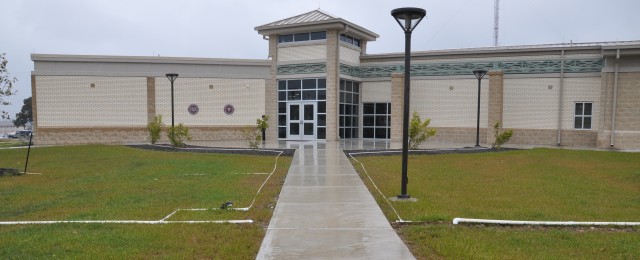CAMP BULLIS, Texas -- On a military installation dedicated to training the warfighter, it's a fitting tribute to have a clinic dedicated to a medic who died a hero on the battlefield.
The Spc. Taylor J. Burk Medical Clinic at Camp Bullis opened its doors Jan. 13, almost five years after its namesake, an Army medic with the 1st Battalion, 8th Cavalry Regiment, 1st Cavalry Division, was killed in Iraq after an improvised explosive device hit the vehicle in which he was traveling on Jan. 26, 2005. (See associated story on pages 4-5 for more about Specialist Burk's life.)
The new 15,823-square-foot facility is located in Building 5206, directly across from the flagpole at the training site. It cost $6.5 million to build and replaces a smaller modular building next door that was temporarily designed to meet the health care needs for Soldiers training at the 27,000-acres-plus site.
Construction began in June 2008 and wrapped up 500 days later in November 2009. After bringing in all the furnishings and medical equipment, the Burk clinic was ready to go a little over two months later.
"Our old clinic was very limited in what we could offer," said Dr. James J. Garcia, chief of the Burk Clinic. "The parking lot was small, we only had six exam rooms and our administrative staff was housed in a separate building. After watching the new facility being built during the last year and a half, we were all elated to finally move in and be able to offer our patients better and faster service."
Describing the difference between the old and new clinics as "night and day," Garcia said it's the service members and beneficiaries that come out ahead.
"Everything here is state of the art," Garcia noted. "The patients have been extremely happy to be treated in such a modern facility that offers them so much more than before."
The Burk Clinic can house more than 20 staff members and includes 14 exam rooms, two patient treatment rooms, five offices and a conference room. Some of the available services include chronic disease management, preventative health care services, immunizations, urgent care, radiology, laboratory, pharmacy and a licensed clinical social worker to provide marriage, Family and individual counseling.
"The treatment rooms can be used to treat lacerations, casting, splinting and to provide intravenous fluids in cases of dehydration - all ailments one would expect to see on a military training base," Garcia said.
"The mission of the clinic is to provide accessible, high-quality health care to enrolled active duty Soldiers, their dependents and Tricare Prime beneficiaries from infants to 64 years old," said Debra Steever, transition officer for the Camp Bullis health clinic project. "Most importantly, this facility is the medical support for all trainees and Soldiers who are conducting training operations on Camp Bullis."
While it looks much like any military medical clinic anywhere, Garcia said it's still an unusual feeling for him to hear the sound of live gunfire permeating the air as he comes in or leaves the building.
"Hearing small arms and machine gun fire reminds us why we are here," Garcia said. "With the huge increase in training activities by all branches of the military going on here, this facility was sorely needed."
Camp Bullis is used primarily as training grounds for U.S. Army, Air Force and Marine Corps combat units. It is also utilized as a field training site for the various medical units stationed at Fort Sam Houston, especially the U.S. Army Medical Department Center & School and the Medical Education and Training Campus.
Now standing empty, the old clinic building next door will likely be reclaimed and another use will be found for it, Garcia said. At the back of the old building, the tiny area that once housed the X-ray machine still stands apart from the building.
"It's certainly come a long way from what we had," said Radiology Technician Michael Greene. "That little structure next to the old clinic was there when I went through training in 2002, and it was more than 20 years old back then. With our new facility, we can offer any kind of X-ray service, short of a CAT (computed axial tomography) scan or magnetic resonance imaging scan."
In the pharmacy, efficiency is taken to another level, according to Pharmacist David G. Dunlop.
"For about 25 percent of our medications, the Scriptpro Pharmacy Automation machine practically does all the work for us," Dunlop said, explaining that the machine can read bar codes, sort, dispense, bottle and label the medications automatically. "We are the first clinic in the entire Army to have one of these. This is a great tool to use in error prevention and making sure the patient gets the right dosages and the right medicine."
In the clinic laboratory, speed and efficiency are two of the biggest advantages noticed in the new facility.
"It's as well equipped as anyplace I've worked," said medical laboratory technician Spc. Hiram J. Virchis. "We can get lab results in minutes instead of days, when we used to have to send samples to BAMC for analysis. These rapid tests are great, especially in this kind of training environment. If we have a Soldier come in from training for a lab test, we can get results back in 10 or 20 minutes, and either get him back in the field or refer him for further treatment. This saves a lot of time and money as down time is decreased dramatically."
"The patients we've seen seem a lot more comfortable than in the old clinic building," said Physician's Assistant Kelly Eberhard. "And it's definitely the nicest place I've ever worked in."




Social Sharing